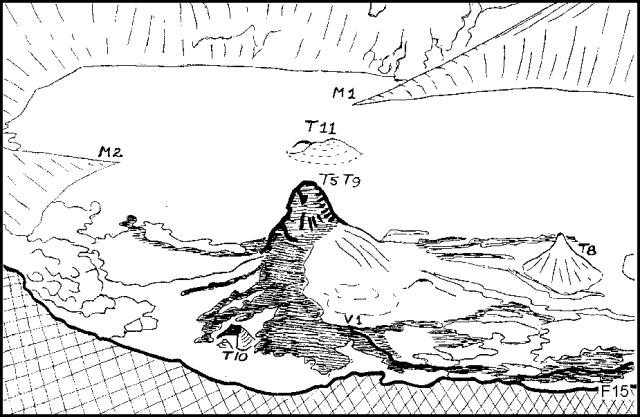Report on Ol Doinyo Lengai (Tanzania) — May 1990
Bulletin of the Global Volcanism Network, vol. 15, no. 5 (May 1990)
Managing Editor: Lindsay McClelland.
Ol Doinyo Lengai (Tanzania) New lava flows from previously active summit crater vent
Please cite this report as:
Global Volcanism Program, 1990. Report on Ol Doinyo Lengai (Tanzania) (McClelland, L., ed.). Bulletin of the Global Volcanism Network, 15:5. Smithsonian Institution. https://doi.org/10.5479/si.GVP.BGVN199005-222120
Ol Doinyo Lengai
Tanzania
2.764°S, 35.914°E; summit elev. 2962 m
All times are local (unless otherwise noted)
During an overflight on 2 May 1990, L. Eshelman and pilot W. Wood observed and photographed evidence of continued carbonatite lava production on the crater floor (figure 16). Persistently active vent T5/T9, the probable center of lava production since October, had grown noticeably since Eshelman's 7 March overflight. Its compound form of previous months had been obliterated by the addition of new material to the upper slopes, and on 2 May it formed a single broad cone rising to a narrow peak. Much of the upper part of the cone was very dark gray, indicating that it had been covered by lava or spatter within the past 24 hours. No single large vent was evident, but a number of black patches on its upper slopes appeared to mark small vents, and lava had also been emitted from small vents around the cone's lower slopes. Lava from T5/T9 had reached T4/T7 and flowed around T8, and white older lava surrounding T10 was partially covered by fresh, very dark gray lava from T5/T9. The fresh flows were estimated at 10-100 m long, 1-5 m wide, and probably at most a few centimeters thick. Other small flows extended N, NE, and SE from T5/T9; only a few short flows (probably
Wood observed lava being emitted from a vent (V1) on the lower NE flank of T5/T9, and photographs show a narrow channel carrying lava toward the N. Liquid lava from this vent was visible at point F15 (figure 16) and several nearby small flows appeared to have been formed during the preceding few hours.
 |
Figure 16. Tracings of oblique airphotos taken by L. Eshelman, 2 May 1990, looking roughly S across the active crater at Ol Doinyo Lengai. Dark areas show fresh lava flows. Courtesy of C. Nyamweru. |
Yellowish areas on T8 implied deposition of sulfur sublimates, but the vent appeared otherwise unchanged. Dark, apparently fumarolic deposits extended from three vents on the ridge crest at T4/T7. Neither showed any signs of fresh lava. No activity was evident at T11. The W side of the crater floor was pale to medium gray with no clear flow outlines.
The area covered by lava S of the former saddle (M2/M1) may have widened slightly since 7 March, but did not appear fresh, nor were there any new vents visible nearby.
Geological Summary. The symmetrical Ol Doinyo Lengai is the only volcano known to have erupted carbonatite tephras and lavas in historical time. The prominent stratovolcano, known to the Maasai as "The Mountain of God," rises abruptly above the broad plain south of Lake Natron in the Gregory Rift Valley. The cone-building stage ended about 15,000 years ago and was followed by periodic ejection of natrocarbonatitic and nephelinite tephra during the Holocene. Historical eruptions have consisted of smaller tephra ejections and emission of numerous natrocarbonatitic lava flows on the floor of the summit crater and occasionally down the upper flanks. The depth and morphology of the northern crater have changed dramatically during the course of historical eruptions, ranging from steep crater walls about 200 m deep in the mid-20th century to shallow platforms mostly filling the crater. Long-term lava effusion in the summit crater beginning in 1983 had by the turn of the century mostly filled the northern crater; by late 1998 lava had begun overflowing the crater rim.
Information Contacts: C. Nyamweru, Kenyatta Univ.

